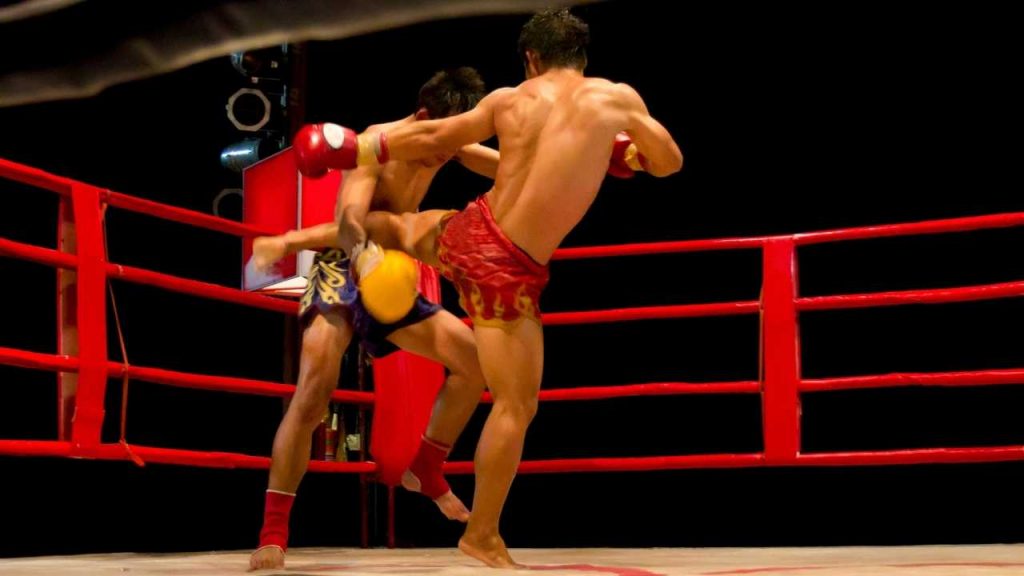Mixed martial arts is a brutal sport but it’s far from lawless. There are a distinct set of rules which fighters need to abide by. These are generally in place to stop the most brutal of blows, with one knee strike in particular being outlawed.
Here we’ll take a closer look at when kneeling your opponent is not allowed. We’ll also check out the penalties for it and some famous instances of an illegal knee. Let’s get started!
Table of Contents
What Is an Illegal Knee in UFC?
In the Unified Rules of MMA, a knee is deemed illegal if it is directed at the head of a grounded opponent. If a fighter has any body part on the canvas aside from the soles of their feet, they cannot be kneed (or kicked for that matter) in the head.
A knee to the body of a grounded opponent would be allowed and we can often see this during grappling. On the flip side, a knee to the head of a standing opponent is allowed, such as Jorge Masvidal’s incredible knee for the quickest UFC knockout ever.
The specific wording of the illegal knee rule is:
“A grounded fighter is defined as: Any part of the body, other sole of the feet touching the fighting area floor. To be grounded, the palm of one hand (a flat palm) must be down, and/or any other body part must be touching the fighting area floor. A single knee, arm, (not fingers) makes the fighter grounded without having to have any other body part in touch with the fighting area floor. At this time, kicks or knees to the head will not be allowed.”
Impact of Illegal Knees in UFC
Like many of the rules in the UFC, the illegal knee can be controversial, but most people seem to agree that the MMA knee rule makes sense. A grounded opponent is in a very vulnerable position and a knee to the head is a severe blow.
Illegal knees not only cause immediate danger and potential injury to the downed opponent, but they can affect their ability to continue the fight. This has often led to a few controversies, which we talk about in more detail later.
As with the illegal 12-6 elbow strike, many will argue that any other type of knee strike is equally as dangerous but the line needs to be drawn somewhere. If the rule wasn’t there, we’d see many more fighters delivering these sickening blows.
Penalties for Illegal Knees in UFC
The penalty for banned MMA moves is down to the referee but they’ll generally come to one of two conclusions. Before that, they should call a time-out to the contest as soon as the illegal knee is landed.
Following that, he will give the struck opponent time to recover. Often the doctor will come into the octagon and check whether or not they are concussed. A call will then be made on whether or not the fighter can continue.
If they can go on, then it’s usual for the referee to deduct one point. The fight will then go on as normal. The point deduction makes it more difficult for the offending fighter to win the contest, should it go to a decision.
If they can’t go on, the referee will call an end to the contest and the opponent that took the knee will win via disqualification, or in some cases it will be called a No Contest. Controversy can come from how it’s decided whether a fighter can continue or not.
Notable UFC Fights Featuring Illegal Knees
It’s not uncommon for a fight to be stopped for illegal strikes in UFC. While the UFC knee to head rule has been applied in plenty of fights, here are the five most famous examples of the UFC knee rules.
Petr Yan against Aljamain Sterling – UFC 259
This is probably the most famous instance of an illegal knee as the stakes were so high. This fight was for the UFC Bantamweight Championship with Yan being the current champion at the time.
Yan was standing over the grounded Sterling for around seven seconds and the referee had even called ‘grounded’. Yet shockingly Yan delivered a sickening knee which sent Sterling to the canvas.
The referee didn’t even bother giving Sterling a chance to recover and instead quickly called the fight in his favor. Following the fight, there was a war of words between the two but in their eventual rematch, Sterling would beat him again, this time by split decision.
Greg Hardy against Allen Crowder – UFC Brooklyn
Greg Hardy is a former NFL player who decided to see if he could make it in the UFC. His career started well with three wins but in his fourth, he lost via disqualification in the second round.
It was a clear illegal knee and the DQ was an obvious call. Hardy was apologetic after the fight, claiming that the knee was down to his inexperience. Given his bemused reaction after the referee stepped in, it looked as though he didn’t know the rule existed.
Michel Pereira against Diego Sanchez – UFC 167
This stoppage was quite controversial for a few reasons. Firstly, the illegal knee was a very marginal call. While technically correct, Sanchez only just had his knee down, which would have been very difficult for Perreira to see.
Secondly, the doctor had ruled Sanchez fit to continue but, having been dominated for most of the fight, Sanchez didn’t want to continue. Many thought he took the easy way out by taking a DQ win instead of fighting on.
Michael Bisping against Jorge Rivera – UFC 127
This is a fight containing an illegal knee which was allowed to continue. In the first round, Bisping landed an illegal knee as Rivera was trying to get up. The downed fighter was given time to recover and was able to do so.
It seemed he had got all of his senses back as he managed to drop Bisping in the second round. However, Bisping was able to survive and delivered his own knockdown later in the round. Bisping didn’t let him off the hook and the fight was soon stopped.
Eddie Alvarez against Dustin Poirier – UFC 211
This was another controversial decision, partly because the Texas commission that the fight was under was yet to be operating under the unified rules. Here Alvarez landed two illegal knees against Poirier, who was against the fence.
The referee Herb Dean spotted the knees and gave Poirier time to recover, but he felt unable to continue. Rather than give the decision to Poirier via disqualification, Dean called it a No Contest as he believed the knees to be accidental because Alvarez didn’t know his opponent was grounded.
FAQs
Can you kick a downed opponent in UFC?
It depends on where you kick them! A fighter is allowed to kick a downed opponent anywhere on the body except the head. This is exactly the same rule for knee strikes, which are also allowed on the body of a grounded opponent.
Why was Yan’s knee illegal?
You can’t knee a grounded opponent in the head. As the rules state “A single knee, arm, (not fingers) makes the fighter grounded”. Sterling’s knee was clearly grounded and had been for several seconds. The knee was not even close to being legal.
Is it legal to kick the knee in MMA?
Yes, this is not one of the UFC banned moves. The Unified Rules of MMA make absolutely no reference to kicks to the knee being illegal. You don’t see these kicks often as a side kick to the knee can cause serious injury to the fighter delivering the kick if they connect with the knee bone.


